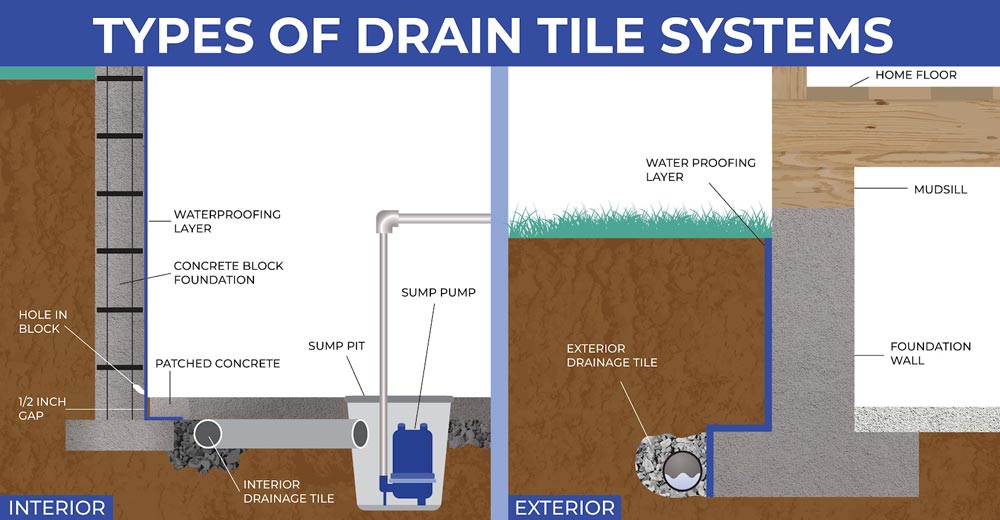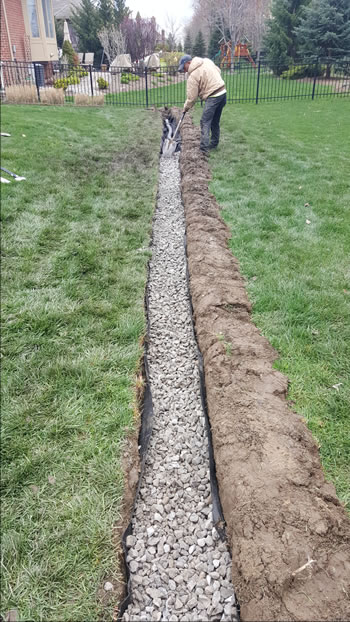Prevent Water Damage with a Professionally Done Portland French Drain
Prevent Water Damage with a Professionally Done Portland French Drain
Blog Article
The Necessary Guide to Preserving Your French Drainpipe for Durable Efficiency
Keeping your French drain is vital to its effectiveness and your home's defense. Routine checks can save you from pricey repairs and water damages. You'll wish to know what signs to search for and how commonly to examine your system. Plus, understanding the cleansing procedure can make a significant distinction. Allow's explore the crucial steps for ensuring your drainpipe operates well for several years ahead.
Understanding the Feature of a French Drain
A French drain is an important element in handling water around your home. It routes excess water far from your structure, preventing flooding and damage. When heavy rainfall falls, the drainpipe collects water via a perforated pipeline hidden in gravel. This system permits water to flow freely, reducing stress on your basement walls and reducing the risk of leaks.You might ask yourself how it operates in method. As water fills the soil, gravity pulls it towards the drainpipe. The perforated pipe records this water, transporting it to an assigned drain location or storm sewage system. This procedure maintains your yard dry and shields your home's architectural integrity.Understanding just how a French drain features is essential to appreciating its importance. By efficiently directing water away, it assists preserve a dry and risk-free living environment. So, keeping your French drainpipe in top problem warranties you stay clear of costly repair services down the line.
Regular Evaluations: What to Search for
When you're inspecting your French drainpipe, start by examining for any type of obstructions that may be blocking water flow. Focus on signs of surface disintegration around the drainpipe, as this can show potential issues. Normal assessments will assist maintain your water drainage system working efficiently.
Blocked Drainpipe Analysis
Just how can you tell if your French drain is obstructed? Initially, look for water pooling in your backyard, particularly after hefty rainfall. If you notice locations where water collects rather of draining pipes, that's a warning. You need to additionally examine the drainpipe electrical outlet; if water isn't flowing out as it should, there's likely a clog. Listen for uncommon gurgling sounds, which can indicate trapped air. Furthermore, evaluate the drain's surface for any kind of plant life growth, as roots can infiltrate and clog the system. If you smell moldy odors, it could direct to stationary water triggered by a blockage. Routinely evaluating these indicators can help you maintain your French drainpipe effectively and protect against costly repair services.
Surface Erosion Check

Cleansing Your French Drain: Step-by-Step Overview
Cleaning your French drainpipe is vital for keeping it working properly. You'll need some details tools and a clear process to ensure everything runs smoothly. Allow's go through the steps and ideas for maintaining your drain successfully.
Tools You'll Need
To deal with the job of cleansing your French drainpipe properly, you'll wish to gather a few important tools. Get a durable pair of gloves to safeguard your hands from debris and sharp objects. A small shovel or trowel will help you remove dirt or blockages around the drain. For removing the interior, a plumbing technician's serpent or a high-pressure water nozzle can be unbelievably useful. You'll also need a bucket for collecting any kind of particles you take out. Having a yard hose on hand will certainly make it simpler to wash out the drain and guarantee it's moving efficiently. With these tools ready, you'll be established for a thorough cleansing session!
Cleaning Up Process Actions
Begin by examining the area around your French drainpipe for any kind of visible debris or obstructions. Remove fallen leaves, branches, or dirt that might obstruct water flow. Next off, check the inlet and electrical outlet areas; clear any blockages to guarantee correct drain. Use a yard hose pipe to purge the drain, directing water right into the inlet. This helps displace any accumulated sludge or debris. Take into consideration utilizing a plumber's serpent to break them up if you notice consistent blockages. After cleansing, check the gravel around the drain; restore it if it's cleaned away. Verify the drainpipe covers are undamaged and securely in location to protect against debris from going into. Normal cleaning maintains your French drainpipe working effectively.
Upkeep Regularity Tips
While regular maintenance is crucial for your French drainpipe's longevity, understanding just how often to maintain it can make all the difference. Ideally, you must evaluate your French drain at the very least two times a year, ideally in springtime and fall. After heavy rains or snowmelt, check for obstructions or debris. If you discover any type of standing water, it's time to cleanse your drain.In areas with hefty vegetation, even more constant upkeep-- about every three months-- may be required. Additionally, take into consideration cleansing your French drainpipe after significant tornados or if you observe water merging in your backyard. By remaining aggressive, you'll guarantee your French drain features effectively and protects your property from water damage. Regular checks will certainly conserve you money and time in the lengthy run.
Recognizing Usual Concerns and Their Solutions
When you see water merging in your backyard or damp areas in your basement, it's important to determine typical issues with your French drain and implement reliable remedies. One frequent trouble is blocking, usually triggered by debris like fallen leaves or debris. To fix this, you can make use of a pipes snake or a high-pressure water jet to clear blockages.Another issue could be incorrect slope. If your drainpipe isn't sloped redirected here appropriately, water will not stream away from your home. You can change the slope by excavating and repositioning the drain pipe.Lastly, check for damage or fractures in the drain itself. Changing the harmed sections is essential for peak performance if you locate any type of. By addressing these problems without delay, you'll help assure that your French drainpipe proceeds to work efficiently, securing your residential property from water damages and keeping a completely dry, risk-free atmosphere.
Seasonal Upkeep Tips for Your French Drainpipe
Resolving usual issues with your French drainpipe is simply the very first step in assuring its long-term efficiency. Seasonal maintenance is crucial for peak performance. In the springtime, remove leaves and debris that may have accumulated during winter. Look for any type of obstructions in the electrical outlet or catch basin, as water needs a clear course to flow freely.During summer, inspect your drainpipe for any kind of signs of shifting or resolving soil. Make certain it's still level and operating correctly. As loss approaches, clean any type of fallen entrusts to stop blockages before winter season arrives.In winter months, look for freezing temperatures. Make certain your drain isn't at risk of freezing if you live in a cool climate. Protecting revealed pipelines can help. Routine checks and prompt upkeep can prevent pricey repairs and maintain your French drain working successfully year-round. Stay proactive and take pleasure in tranquility of mind recognizing your drainage system remains in great form!
When to Call a Specialist
Understanding when to hire a specialist can conserve you time and avoid additional damages to your French drain. If you see relentless standing water in your lawn, it's a clear sign that your drainpipe may be blocked or damaged. Do not neglect unusual odors, as they can show sewage back-up or degeneration, which requires prompt attention.If you locate that your drain isn't functioning correctly after attempts to clean or keep it, it's time to get to out for professional help. Furthermore, if you're unsure concerning the underlying concerns or do not have the required tools, employing a specialist can give peace of mind.Finally, if your French drainpipe is old or has actually experienced substantial deterioration, professional analysis can figure out whether repair services or full substitute is required. Trust the experts to guarantee your water drainage system works effectively for several years ahead.
Tips for Avoiding Future Drainage Troubles
To keep your French drainpipe functioning effectively, frequently checking and maintaining it can make all the distinction. Beginning by clearing debris, leaves, and dust from the surface area and drainpipe openings. This prevents clogs that can result in water backup. Inspect the crushed rock around the drain; if it's compressed or deteriorated, consider adding fresh crushed rock to maintain optimal flow.Next, draw away water away from your drainpipe by guaranteeing seamless gutters and downspouts are clear and blog here routing water at least three feet far from your foundation. Frequently examine for any signs of damage or drooping. If you observe concerns, address them immediately.Finally, take into consideration setting up a filter or a catch basin to trap larger particles before it goes into the drainpipe. By staying proactive with these ideas, you'll minimize the threat of future drain problems and maintain your French drainpipe in top shape.
Often Asked Concerns
How much time Does a French Drain Commonly Last?
A French drain generally lasts around 30 to 40 years, depending upon the materials made use of and upkeep (Portland French Drain). If you keep up with normal checks, you can expand its life expectancy also further
Can I Mount a French Drainpipe Myself?
Yes, you can set up a French drain yourself if you have actually obtained the right devices and knowledge. Just make certain to prepare carefully, adhere to regional guidelines, and assurance correct drain to avoid future issues.
What Materials Are Made Use Of in a French Drainpipe?
You'll require perforated pipeline, gravel, landscape material, and a strong water drainage pipeline for your French drain. These materials aid reroute water efficiently, protecting against flooding click this site and maintaining your property completely dry and risk-free from water damage.

Is a License Required to Mount a French Drainpipe?
You'll likely need a permit to mount a French drainpipe, depending upon regional guidelines. Talk to your district to assure you comply with any essential guidelines and stay clear of prospective issues throughout installation.
What Are the Expenses Related To French Drainpipe Maintenance?
Keeping a French drainpipe usually sets you back in between $100 and $500 each year. You'll require to consider expenditures for cleaning, fixings, and examinations. Normal upkeep aids prevent larger costs and warranties your system operates effectively for several years - Portland French Drain. When you're examining your French drainpipe, begin by checking for any type of blockages that could be blocking water flow. By staying aggressive, you'll assure your French drainpipe functions successfully and secures your building from water damage. When you see water pooling in your lawn or damp places in your basement, it's important to identify common concerns with your French drain and carry out effective solutions. You can change the incline by digging and repositioning the drainpipe pipe.Lastly, check for damage or fractures in the drain itself. Examine the gravel around the drainpipe; if it's compacted or worn down, consider including fresh crushed rock to maintain suitable flow.Next, divert water away from your drain by ensuring downspouts and seamless gutters are clear and directing water at least 3 feet away from your structure
Report this page